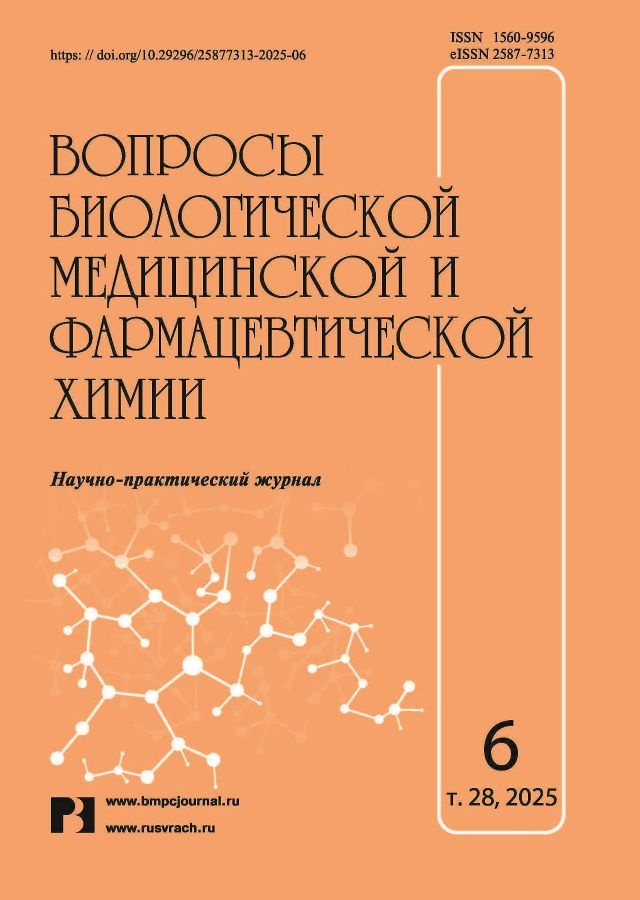Study of the absorbent properties of alginic acid
- Authors: Zakharov А.S.1, Barishnikova M.I.1, Saf’yanov M.A.1, Vasilovsky I.N.1, Korotkova N.V.1, Sukhova А.А.1, Fomina D.I.1, Ivankina I.V.1
-
Affiliations:
- Ryazan State Medical University
- Issue: Vol 28, No 6 (2025)
- Pages: 14-20
- Section: Biological chemistry
- URL: https://journals.eco-vector.com/1560-9596/article/view/685475
- DOI: https://doi.org/10.29296/25877313-2025-06-02
- ID: 685475
Cite item
Abstract
Introduction.Alginicacidis a naturalheteropolysaccharide of brownalgae,consistingofresidues of mannuronicandguluronicacids.It is usedinvariousfields:medicine,foodandpharmaceuticalindustry,cosmetology,ecology,etc. Itsability to bindandretainwatertoformhydrogels is usedin the development of newtechnologiesandmaterials. The structure of thiscompoundisinterestingfrom the point of view of studyingitsabsorbentpropertiesinrelationtosubstances of variouscompositionandstructure.
Material and methods.thestudypresentsvariousmethods for determiningsolutionconcentrationsbasedonphotocolorimetricandspectrophotometricanalysis.Thefollowing compounds wereselectedasexperimentalcompoundsfor the study of absorbentactivity: anions–nitrite,sulfate,iodide;metalcations–calciumandiron(III);protein–glutathione;organicdyes–methyleneblueandmethylorange.
Results.during the study, it turned out thatalginicacidcanabsorb the followingcompounds:nitriteanions-by90.4%,sulfateanions–by71.8%,iodideanions–by28.34%,calciumcations–by58.06%,iron(III)cations–by75.41%,protein–by48.33%,methyleneblue–by 84.22%andmethylorange–by83.72%. The authorssuggestthat the specificabsorbingactivity of alginicacidcan be explained by the followingproperties: alginicacidbindsmetalionsdue to the content of carboxylgroupsand a change in the gelstructureduringswelling; absorption of proteins is caused by electrostaticinteractionwithalginicacidandcompetitionwithmetalcationsforbindingtocarboxylgroups;absorption of anionscanbeassociatedwithelectrostaticinteractionwithcarboxylgroups.
Conclusions. alginic acid has a pronounced absorbent ability in relation to a wide range of compounds of various chemical nature. This feature makes alginic acid a compound suitable for use in filtration and dialysis systems for various purposes, including medical ones.
Keywords
Full Text
About the authors
А. S. Zakharov
Ryazan State Medical University
Author for correspondence.
Email: AlexanderZakharov2019@yandex.ru
ORCID iD: 0000-0002-4004-7474
SPIN-code: 4906-9088
Assistant of the Department of Biological Chemistry
Russian Federation, Visokovoltnaya str., 9, Ryazan, 390026M. I. Barishnikova
Ryazan State Medical University
Email: masha.bari04@gmail.com
ORCID iD: 0009-0004-0407-6536
Student of the Faculty of General Medicine
Russian Federation, Visokovoltnaya str., 9, Ryazan, 390026M. A. Saf’yanov
Ryazan State Medical University
Email: bellkoks@yandex.ru
ORCID iD: 0009-0008-3895-0171
Student of the Faculty of General Medicine
Russian Federation, Visokovoltnaya str., 9, Ryazan, 390026I. N. Vasilovsky
Ryazan State Medical University
Email: vania_vania_2018@list.ru
ORCID iD: 0009-0005-0294-4990
Student of the Faculty of General Medicine
Russian Federation, Visokovoltnaya str., 9, Ryazan, 390026N. V. Korotkova
Ryazan State Medical University
Email: fnv8@yandex.ru
ORCID iD: 0000-0001-7974-2450
SPIN-code: 3651-3813
Ph.D. (Med.), Associate Professor, Docent of the Department of Biological Chemistry
Russian Federation, Visokovoltnaya str., 9, Ryazan, 390026А. А. Sukhova
Ryazan State Medical University
Email: rrraaa724@gmail.com
ORCID iD: 0009-0006-5482-6969
Resident
Russian Federation, Visokovoltnaya str., 9, Ryazan, 390026D. I. Fomina
Ryazan State Medical University
Email: fnv8@yandex.ru
ORCID iD: 0009-0008-5532-6303
Student of the Faculty of General Medicine
Russian Federation, Visokovoltnaya str., 9, Ryazan, 390026I. V. Ivankina
Ryazan State Medical University
Email: ira.ivankina.02@mail.ru
ORCID iD: 0009-0000-6789-8853
Student of the Faculty of General Medicine
Russian Federation, Visokovoltnaya str., 9, Ryazan, 390026References
- Ryabova M.N., Seleznev A.V., I.A. Fokin i dr. Primenenie mannitol termostabilizirovanny`x GK-kompleksov v lechenii gonartroza. Nauka molody`x (Eruditio Juvenium). 2022; 10(3): 277–288. (In Russ.). doi: 10.23888/HMJ2022103277-288.
- Lipatov V.A., Fronchek E`.V., Grigor`yan A.Yu. i dr. Ocenka e`ffektivnosti novy`x obrazczov mestny`x krovoostanavlivayushhix sredstv na osnove xitozana posle rezekcii pecheni v e`ksperimente. Rossijskij mediko-biologicheskij vestnik im. akademika I.P. Pavlova. 2023; 31(1): 89–96. (In Russ.). doi: 10.17816/PAVLOVJ108094.
- Podkorytova A.V., Roshhina A.N. Morskie burye vodorosli – perspektivnyj istochnik BAV dlja medicinskogo, farmacevticheskogo i pishhevogo primenenija. Trudy VNIRO. 2021; 186(4): 156–172. (In Russ.). doi: 10.36038/2307-3497-2020-181-235-256.
- Zaharova V.A., Fidorovskaja Ju., Hlystova T.S. I dr. Proizvodnye al'ginovoj kisloty: osobennosti stroenija, svojstva i perspektivy ispol'zovanija v medicine. Industrial Processes and Technologies. 2022; 2(5): 64–79. (In Russ.). doi: 10.37816/2713-0789-2022-2-5(7)-64-79.
- Kuznecova T.A., Besednova N.N., Usov V.V. i dr. Biosovmestimye i biodegradiruemye ranevye pokrytija na osnove polisaharidov iz morskih vodoroslej (obzor literatury). Vestnik hirurgii imeni II Grekova. 2020; 179(4): 109–115. (In Russ.). doi: 10.24884/0042-4625-2020-179-4-109-115.
- Kalis E.J.J., Davis T.A., Town R.M. et al. Impact of pH on CdII partitioning between alginate gel and aqueous media. Environmental Chemistry. 2009; 6(4): 305–310. doi: 10.1071/EN09060.
- Zhang Y., Zhao K., Yang Z. et al. Calcium alginate and barium alginate hydrogel filtration membrane coated on fibers for molecule/ion separation. Separation and Purification Technology. 2021; 270: 118761. doi: 10.1016/j.seppur.2021.118761.
- Zhao K., Zhang X., Wei J. et al. Calcium alginate hydrogel filtration membrane with excellent anti-fouling property and controlled separation performance. Journal of Membrane Science. 2015; 492: 536–546. doi: 10.1016/j.memsci.2015.05.075.
- Abka-Khajouei R., Tounsi L., Shahabi N. et al. Structures, Properties and Applications of Alginates. Marine Drugs. 2022; 20(6): 364. doi: 10.3390/md20060364.
- Rinaudo M. On the abnormal exponents aν and aD in Mark Houwink type equations for wormlike chain polysaccharides. Polymer Bulletin. 1992; 27: 585–589. doi: 10.1007/BF00300608.
- Giridhar Reddy S. Alginates – A Seaweed Product: Its Properties and Applications. Properties and Applications of Alginates. 2021. doi: 10.5772/intechopen.98831.
- Golmohamadi M., Wilkinson K.J. Diffusion of ions in a calcium alginate hydrogel-structure is the primary factor controlling diffusion. Carbohydrate polmers. 2013; 94(1): 82–87. doi: 10.1016/j.carbpol.2013.01.046.
- Zhao L., Wang J., Zhang P. et al. Absorption of Heavy Metal Ions by Alginate. Bioactive Seaweeds for Food Applications. Bioactive Seaweeds for Food Applications. 2018: 255–268. doi: 10.1016/B978-0-12-813312-5.00013-3.
- Gao N., Xie W., Xu L. et al. Characterization of a chlorine resistant and hydrophilic TiO2/calcium alginate hydrogel filtration membrane used for protein purification maintaining protein structure. International Journal of Biological Macromolecules. 2023; 253(6): 126367. doi: 10.1016/j.ijbiomac.2023.126367.
- Zhao D., Shen Z., Shen X. Dual-functional calcium alginate hydrogel beads for disinfection control and removal of dyes in water. 2021; 188: 253–262. doi: 10.1016/j.ijbiomac.2021.07.177.
Supplementary files







